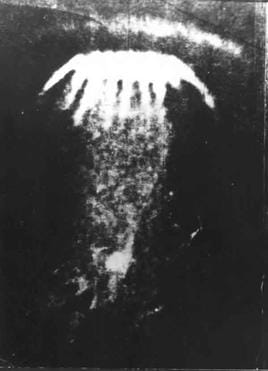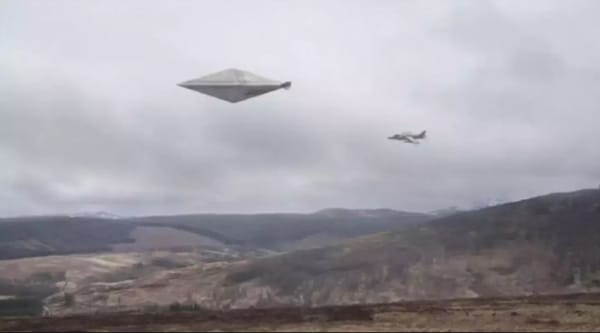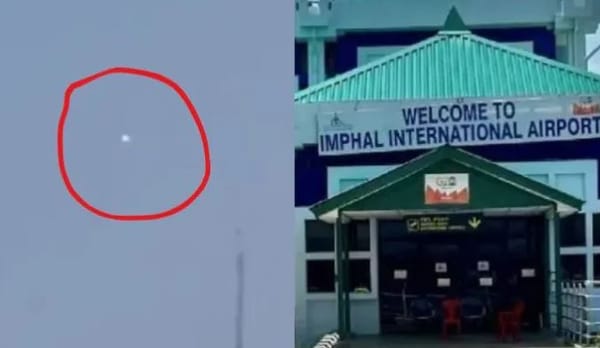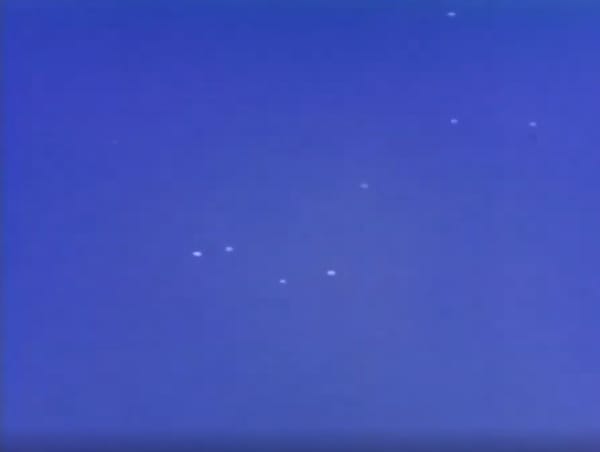The 1977 Petrozavodsk Incident

On September 20, 1977, a series of unusual celestial events were reported across a broad region spanning from Copenhagen (Denmark) to Vladivostok (Russia). Known as the Petrozavodsk phenomenon, these sightings were characterized by a luminous, unidentified object observed over Petrozavodsk, Russia, which appeared to radiate multiple beams of light. The phenomenon garnered significant attention from government officials and scientific communities, prompting investigations into its origins.
The phenomenon's widespread visibility led to a variety of proposed explanations, ranging from natural atmospheric occurrences to technical malfunctions of Soviet satellites. Despite extensive analysis by Soviet researchers, the exact nature of the Petrozavodsk phenomenon remains unresolved, contributing to ongoing debates and studies into unusual aerial phenomena.
The Incidents
On the night of September 20, 1977, multiple sightings of an unidentified luminous object were reported across northern Europe and the Soviet Union. The incidents spanned a considerable geographic area, with reports coming from various locations over a period of several hours.
Initial Sightings and Observations
The first notable sightings began around 1:00 AM UTC. In Helsinki, Finland, observers reported seeing a bright, glowing ball in the sky, visible to numerous residents including taxi drivers, police officers, and airport personnel. Similar observations were made in nearby Turku, where two witnesses described seeing a spinning object resembling a large lifebuoy, estimated to be about 10 meters in diameter. The credibility of these reports was later questioned by experts such as Pekka Teerikorpi from Tuorla Observatory, who suggested that the observed distances might have been misjudged due to the object's unfamiliar appearance.
Further sightings were reported at 2:30 AM local time over Loukhi and at 3:00 AM over Kovdor and Palanga (Lithuania). In these locations, witnesses described a luminous object that moved across the sky. The most dramatic account came from the crew of a Soviet fishing vessel, the Primorsk, who reported seeing a glowing object with a luminous aura that abruptly changed direction from east to north.
Observations in the Soviet Union
As the night progressed, similar phenomena were reported across the Soviet Union, primarily in the northwest regions. At approximately 3:00 AM, the supervising personnel at the Leningrad maritime trade port observed a luminous object. The object was described as moving noiselessly and exhibited a sudden change in direction near Primorsk. This was followed by a sighting at 3:30 AM, when the crew of the Primorsk described the object as surrounded by a bright, luminous coat.
In Petrozavodsk, the capital of the Karelian Autonomous Soviet Socialist Republic, the phenomenon was observed around 4:00 AM. Local reports described the object as a "huge star" that emitted rays of light towards the Earth, creating an appearance of "pouring rain." Eyewitness Nikolai Milov, a TASS correspondent, described the object as expanding and pulsating, eventually dispersing a bright "cloud" before moving away. The intensity of the object's glow was compared to that of a full moon, and the phenomenon lasted approximately 10 to 15 minutes.
Detailed Eyewitness Accounts
Several detailed accounts came from various witnesses. In Kurkijoki, engineer A. Novozhilov described the object as resembling an airship, with a faceted structure and brightly shining spots. He reported that the object moved at an altitude of 300–500 meters, approximately 100 meters in length and 12–15 meters in diameter. Novozhilov also observed a bright ball released from the object's rear, which descended behind a forest, causing a bright glow upon landing. Despite taking three photos with a short exposure time, the results were unsuccessful in capturing the object's appearance.
In Saint Petersburg (then Leningrad), three night shift employees at Pulkovo Airport observed a fireball-like object at 3:55 AM. The object was described as slightly larger than Venus, surrounded by a glowing coat with intricate structures, and moving in a manner unlike typical auroras.
The phenomenon was also reported by Soviet writer and philosopher Yuri Linnik, who observed the object through an amateur telescope. Linnik described the object as lens-like, with a translucent ring and pulsating red rays emitted from 16 spots around its edges. The object’s movement was tracked across several star constellations, and its flight lasted about 15 minutes before disappearing in the north.
Further reports were collected from other locations, including Primorsk, Petrodvorets, Lomonosov, and Polovina. Many of these reports were accompanied by drawings from eyewitnesses, contributing to the overall body of data on the Petrozavodsk phenomenon.
These sightings, characterized by their consistency and wide geographic spread, prompted significant attention from both local and international observers. The phenomenon's impact on technical devices and its potential influence on biological activity in observed areas were also noted, adding layers of complexity to the ongoing investigation.
The Impact and Technical Observations
The Petrozavodsk phenomenon's impact extended beyond visual observations. Reports emerged of unusual effects on both technological systems and the environment. In Petrozavodsk, engineers noted "huge failures" in computing devices, which later returned to normal functionality. Additionally, some witnesses, including Yuri Linnik, observed increased biological activity following the incident. Linnik reported a significant blooming of roses and herbaceous plants in his garden, as well as intensified algae growth in Ukshozero, which he described as extraordinary for the season.
In terms of environmental impact, A. Grakov observed a glowing yellow ball over the lake in Petrozavodsk, noting that the air above the lake glowed more intensely than the city's lights. The glowing effect was reported to be more pronounced than typical urban lighting.
Radar and Instrumental Detection
Despite the widespread visual reports, the phenomenon was not detected by some standard radar systems. Radar at Helsinki Airport failed to pick up the object, a claim contested by Ari Hämäläinen, a traffic controller at the airport. Similarly, Soviet air defense systems did not register the object. However, the phenomenon was detected by weather radar at the Karelian Hydrometeorological Observatory in Petrozavodsk on several occasions, including on September 30, October 20, and November 20, 1977. This detection added an additional layer of complexity to the investigation.
Soviet Investigations and Initial Analyses
Following the sightings, the Soviet Academy of Sciences conducted an extensive investigation into the Petrozavodsk phenomenon. Initial analyses by Lev Gindilis from the Sternberg Astronomical Institute considered the possibility of a high-altitude object. Gindilis proposed that if a single object could account for simultaneous observations across various locations, it would have to be at a considerable altitude, possibly around 100 kilometers, with a diameter of several tens of kilometers for the observed brightness and size.
Gindilis and other researchers also explored the hypothesis that the phenomenon might be linked to the Kosmos-955 satellite, launched on the same day. However, this explanation faced challenges, including discrepancies in the object's movement direction and the expected altitude and size. On October 8, 1977, a report published in the Sortavala newspaper supported the notion that the object moved from northeast to southwest, which conflicted with the anticipated trajectory of Kosmos-955.
Further scrutiny by Felix Ziegel and other experts suggested that the phenomenon's extent seemed too large to be attributed solely to a satellite or technical experiment. The preliminary report from October 20, 1977, proposed the possibility of a cosmic influence but did not reach definitive conclusions. The Soviet investigation involved a dedicated meeting on November 1, 1977, at the Institute of Space Studies of the Soviet Academy of Sciences, but the findings remained inconclusive.
International Reactions and Ongoing Debate
The Soviet investigation report, eventually shared with international researchers, was met with mixed reactions. Some, such as J. Allen Hynek and Richard Haines, viewed it as significant evidence of unidentified flying objects. Conversely, critics like James Oberg suggested that the Soviet investigation might have been a diversion or an attempt to obscure the true nature of Soviet UFO research.
In the years following the incident, various proposed explanations included meteorites, auroras, and the chemiluminescence hypothesis. Vladimir Krat initially attributed the phenomenon to a meteorite, while later theories suggested auroras or a combination of satellite launches and solar magnetic perturbations. The chemiluminescence hypothesis, proposed by M. Dmitriyev, was dismissed by some experts due to the energy output required and the object's observed behavior.
The Petrozavodsk phenomenon remains a subject of interest and debate, reflecting the complexities of understanding and interpreting rare and unusual atmospheric events. The diverse observations, technical challenges, and varying explanations underscore the ongoing fascination and investigation into such enigmatic occurrences.
Aftermath
The Petrozavodsk phenomenon had a lasting impact on both scientific research and public interest. The Soviet investigation's inconclusiveness and the variety of proposed explanations sparked continued debate and further research into anomalous atmospheric phenomena.
Impact on Soviet Research
The incident led to the establishment of the Setka AN research program by the Soviet Academy of Sciences, aimed at studying unexplained atmospheric phenomena. This program represented a formal acknowledgment of the need for systematic research into such events, reflecting a broader interest in understanding anomalies in the atmosphere.
Increased Public Interest
The widespread media coverage and the mysterious nature of the Petrozavodsk event captured public imagination both within the Soviet Union and internationally. The phenomenon was often discussed in the context of UFOs and extraterrestrial life, contributing to the growing global interest in such subjects during the late 20th century.
Scientific and Technical Developments
The Petrozavodsk incident also influenced advancements in the field of atmospheric science and satellite observation. The challenges encountered in investigating the phenomenon highlighted gaps in existing detection technologies and methodologies. In response, there was increased emphasis on improving radar systems and other observational tools to better capture and analyze similar events in the future.
Continued Debate and Speculation
Over the years, the Petrozavodsk phenomenon has remained a topic of debate among researchers and enthusiasts. Theories ranging from satellite debris to natural atmospheric phenomena continue to be discussed and scrutinized. The incident is frequently cited in discussions about anomalous aerial phenomena and the challenges of interpreting rare and unusual observations.
Cultural and Media Influence
The Petrozavodsk event has been referenced in various media, including documentaries, books, and articles exploring UFOs and unexplained phenomena. Its impact on popular culture reflects the broader fascination with mysterious and unexplained events, contributing to ongoing discussions and speculation about similar occurrences.
Overall, the aftermath of the Petrozavodsk phenomenon underscores its significance in the history of unexplained aerial phenomena and its role in shaping scientific inquiry and public perception of anomalous events.
Conclusion
The Petrozavodsk phenomenon of September 20, 1977, remains one of the most intriguing and enigmatic events in the study of unexplained aerial phenomena. Despite extensive investigations and numerous eyewitness accounts, the true nature of the event remains unresolved. The incident prompted significant scientific inquiry and established new research avenues into atmospheric anomalies, while also capturing the public's imagination. As both a historical curiosity and a catalyst for ongoing study, the Petrozavodsk phenomenon continues to be a subject of interest and debate within the scientific community and among enthusiasts of the unexplained.



